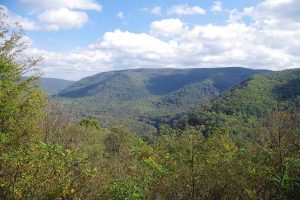There’s no avoiding it.
If you are a parent, or will be in the future, the day will come. Your children will be working on a project. It might be for school, or sports, or work. The exact nature of it doesn’t matter.
But at some point, your kids — tired, frustrated, unsure that success is at all a possibility – will wonder if all the effort is worth it.
Yes, you’ll say, in the most encouraging way possible. Rewards are out there for those willing to keep slogging along, putting one foot in front of the other.
That was my message to my niece, literally.

Overlooks are inspiring at any time of year, but will be especially attractive soon.
Bob Frye/Everybody Adventures
Parking my truck along the river’s edge, we’d started through the woods, winding uphill, always uphill. Our objective was an overlook atop Chestnut Ridge in southwestern Pennsylvania.
We’d been hiking a while, and while we’d seen deer, explored some giant boulders and splashed a bit in a tiny stream, she was a bit foot weary.
Let’s keep going, I said. It will be worth it. Trust me.
Yet, she wasn’t sure initially. I could tell that. But she was game, and determined, and on we went.
And in the end, she decided I was right. The view is spectacular.
From its rocky perch it’s possible to see another, far distant bend of the same river we’d parked beside earlier. From so high up, it looks like a ribbon of glittering silver winding among the forested valley.
Turkey vultures – among other raptors — commonly cruise the air currents along the ridge, too. They’re a couple of thousand feet above the river, but often below the vista itself, so that it’s possible to watch them soar at eye level or even from a bit above.
I particularly enjoy the shadows, though. From the overlook, each fold of the surrounding mountains is revealed. One side, in the sun, will be bright, the other, in shadow, will be dark.
It’s like the world has been turned into a giant 3D map, one you can almost reach out and touch, feeling the dips and swales and ridges and valleys and wrinkles of the planet.
Such views are more common than you’d think.
From Pennsylvania to North Carolina, West Virginia to Tennessee, Maine to Missouri, and places in between, there are scenic overlooks all over the country. They’re not necessarily hard to find either.
Some state park and state forest agencies identify those within their boundaries. National parks and forests often do, too. Trail guidebooks highlight destinations.
Shoot, if worse comes to worse, all you’ve got to do is an internet search for something like “scenic overlooks in…” and list your state.
You’ll get results.
Autumn is, to my mind, one of the best times of all to hike to such spots. The weather is cooler and the bugs are fewer.
But the real draw is the leaves, which cover the soon to be bare landscape like a favorite sweater of many colors.
There’s a science to why leaves change color in the fall, producing amazing displays of reds and yellows and oranges and browns and purples and golds, in all hues. It’s a phenomenon well explained.
That knowledge tells us certain species are, year to year, as reliable as it gets when it comes to showcasing their beauty.
Sugar maples. These may be the boldest of all, growing to 60 feet tall or so and glowing a burnt orange.
Oaks. These come in all varieties, from whites to reds and pins to blacks. The most solid of trees in the forest, they manifest all shades of color, from dark red to copper.
Sassafras. It grows leaves of three different shapes, all on the same tree, so it’s not a surprise that those leaves can exhibit a variety of colors, too. They range from yellow to orange to red. You might even see some pinks.
Aspens. These glow a brilliant yellow at their peak of color. There’s no mistaking an aspen stand in fall.
Shagbark hickory. A favorite of squirrels for the meaty nuts they produce, hickories aren’t the first tree most people think of for color. But they drop soft golden brown leaves that exhibit a subtle, restrained beauty.
Dogwoods. Another tree that comes in multiple varieties, they flower in spring, something that makes them attractive to homeowners and landscapers. But their blood red leaves make them a standout in the fall woods, too.
There are other showy trees out there, of course. The list is a long one. Sweetgum, witch hazel, beech and tupelos, to name a few, star in different places.
All mixed together – in various assortments, based on location and habitat – they blend together artfully to add a romance to the woods unique to autumn.
And, as I shared with my niece that morning and afternoon, their glory is often best enjoyed from on high.
Even if – or maybe because of – the work sometimes required to get there.
Want to see more? Check us out on Facebook, Twitter and Instagram.








